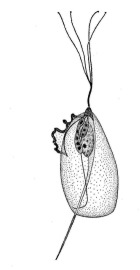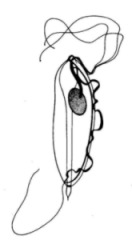
Study of intraspecific polymorphism in trichomonads
Intraspecific
polymorphism of Trichomonas vaginalis

The relationship among 20 strains of Trichomonas vaginalis was analysed by RAPD method using 25 random primers. Considerable amount of polymorphism was detected among these strains. The bootstrap values showed, however, that the relationship of strains is not reliably resolved. Our results suggest that two times more data (50 random primers) would be probably needed to reach satisfactory bootstrap values. We found statistically significant (p=0.0119) correlation between resistance to metronidazol of particular strain and its position in the dendrogram. Also the concordance between the position of the strain in the tree and the difficulty of curing the disease caused by the strain was near to statistical significance (p=0.057). The concordance between localities of isolation of strains and their relationships was slightly above the 5% level of significance (p=0.0607). Our results showed that there is certainly no concordance between presence of dsRNA virus in the strains and their position in the tree (p=0.463). We think that the existence of significant correlation between biological properties of the strains and their possition in the dendrogram independently supports the validity of the tree topology, because it is highly improbable to find such a correlation in a tree with random or wrong topology.
Published:
Articles:
Conferences:
Intraspecific
polymorphism of Tritrichomonas foetus and Tritrichomonas suis

Tritrichomonas foetus causes serious sexually transmitted disease of cattle (bovine trichomoniasis) while Tritrichomonas suis is regarded a harmless comensal of pig's intestine and nose cavity. Since the description of Tritrichomonas foetus possible identity of these two species was widely discussed. We analysed the DNA polymorphism in populations of these species using RAPD method with 29 random primers. We included 6 strains of T. suis and 8 strains of T. foetus in our analysis. We detected certain amount of polymorphism but the polymorfism was not so high as in the case of Trichomonas vaginalis. The relatively high bootstrap values suggested that the phylogenetic tree was well supported by the data. The strains from the two species didn't form distinct branches of the tree but were partially mixed together. This indicates that assemblages of these two species cannot be considered as valid phyletic species. At the same time, we found statistically significant concordance between the position of the strain in the tree and its original host specificity (p=0.045). Striking concordance was also found between the position in the tree and geographical origin of the strains (p=0.0002). From these results we concluded , that Tritrichomonas foetus and Tritrichomonas suis are very likely identical species. The question of the direction of the host shift (from pig to cow or from cow to pig) cannot be answered on the basis of our results. We plan to perform further study which will includ not only strains from domestic animals but also strains from wild living pigs and bovids.
Published:
Article:
Conferences:
Intraspecific polymorphism of Tetratrichomonas gallinarum
Published:
Article:
Conference: